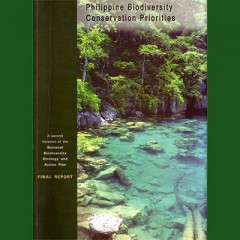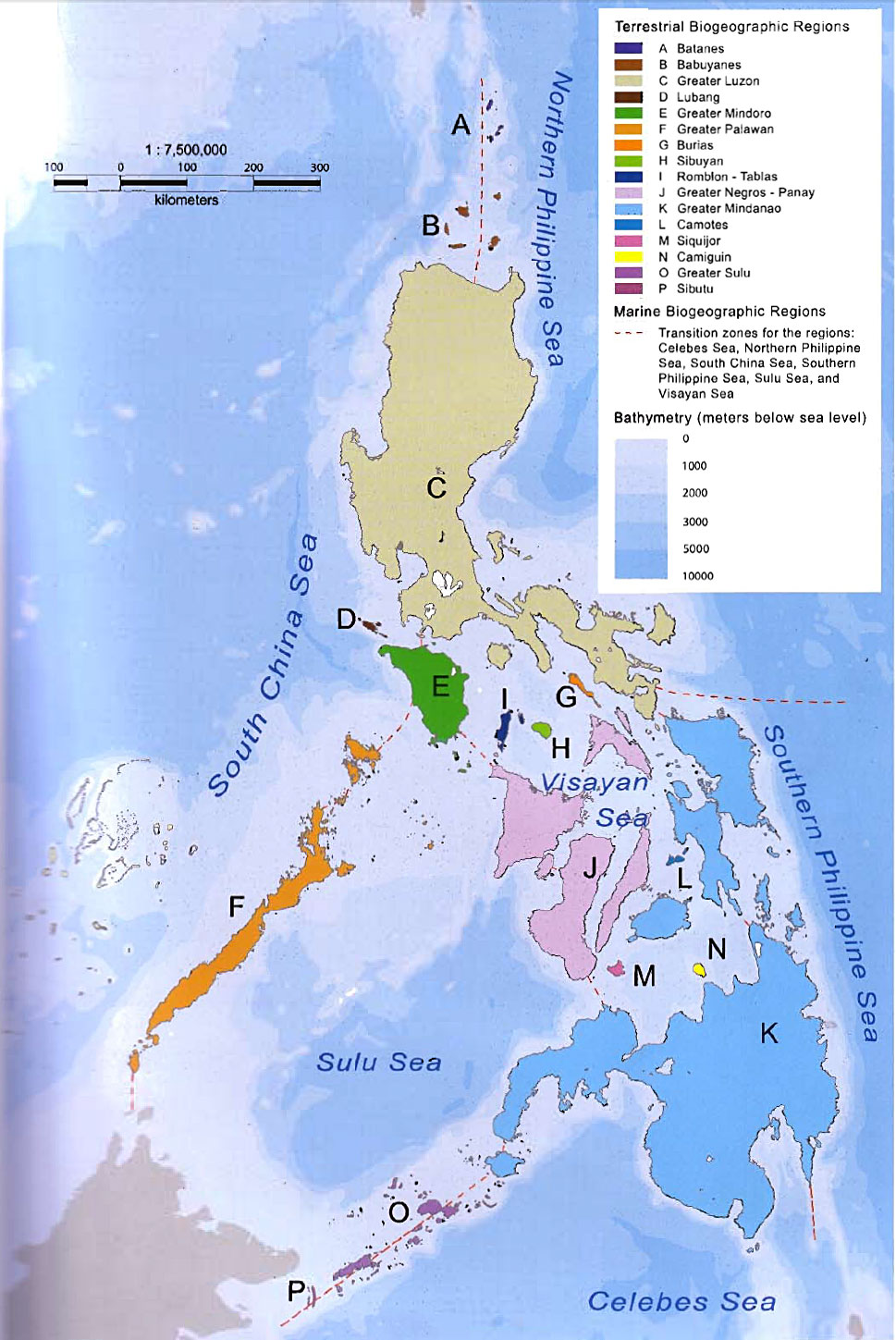Biodiversity Conservation Strategies
2002: The Philippine Biodiversity Conservation Priorities

In 2002, the FPE, in collaboration with the Department of Environment and Natural Resources-Biodiversity Management Bureau (formerly the Protected Areas and Wildlife Bureau or PAWB), Conservation International Philippines (CI Philippines), and the Biodiversity Conservation Program of the University of the Philippines Center for Integrative and Development Studies (BCP-UPCIDS), published a Final Report entitled, “Philippine Biodiversity Conservation Priorities.”
In 2002, the FPE, in collaboration with the Department of Environment and Natural Resources-Biodiversity Management Bureau (formerly the Protected Areas and Wildlife Bureau or PAWB), Conservation International Philippines (CI Philippines), and the Biodiversity Conservation Program of the University of the Philippines Center for Integrative and Development Studies (BCP-UPCIDS), published a Final Report entitled, “Philippine Biodiversity Conservation Priorities.” The publication was based on the Philippine Biodiversity Conservation Priority-setting Program (PBCPP), summarizing input from 300 experts from the scientific and decision-making communities representing over 100 local and international institutions. The report is an update to the Philippine National Biodiversity Strategy and Action Plan (NBSAP), which was first formulated in 1997.
The PBCPP resulted in five key outputs which are listed below and are discussed further below:
- The reassessment and updating of the terrestrial and marine biogeographic regions of the country.
- The mapping of 206 biodiversity conservation priority areas.
- Five (5) strategic actions needed to be implemented in the conservation priority areas.
- The identification of terrestrial and marine biodiversity “corridors.”
- State of the art assessments for each thematic group. What follows is a brief run-through of the highlights of the Final Report. To view the publication in full, click here. For further reference, the 1997 NBSAP may be downloaded from this link.
Philippine Biogeographic Regions
The PBCPP named sixteen (16) terrestrial and six (6) marine biogeographic regions. The terrestrial regions were identified based on the geographic distribution patterns of vascular plants, arthropods, amphibians, reptiles, birds, and mammals, while the marine zones were defined based on the connectivity and dispersal features of an ocean circulation with broad transition zones based on the evolutionary geology of the archipelago and observed associated reef fish assemblages.

The biogeographic regions of the Philippines. Click on the image to view a larger version.
(Source: Philippine Biodiversity Conservation Priorities, 2002)
The terrestrial biogeographic regions are as follows: (1) Batanes, (2) Babuyanes, (3) Greater Luzon, (4) Lubang, (5) Greater Mindoro, (6) Greater Palawan, (7) Burias, (8) Sibuyan, (9) Romblon-Tablas, (10) Greater Negros-Panay, (11) Greater Mindanao, (12) Camotes, (13) Siquijor, (14) Camiguin, (15) Greater Sulu, and (16) Sibutu.
Meanwhile, the six marine biogeographic regions are the (1) Celebes Sea, (2) Northern Philippine Sea, (3) South China Sea, (4) Southern Philippine Sea, (5) Sulu Sea, and (6) Visayan Sea.
Biodiversity Conservation Priority Areas in the Philippines
From the identified biogeographic regions, the PBCPP convenors further noted and mapped out 206 integrated priority areas for biodiversity conservation initiatives, 170 of which are terrestrial and 36 are marine. These biologically important areas were so named according to analyses of data from five taxon-based thematic groups (plants, arthropods, amphibians and reptiles, birds, and mammals), two ecosystem-based groups (inland and marine waters), and one socio-economic group.
The areas identified by the taxon-based and ecosystem-based groups, in light of the input provided by the socio-economic group, were also classified according to level of priority. For the 170 terrestrial priority areas, there are 92 Extremely High, 60 Very High, 3 High, and 15 Insuffecient Data (at the time of the PBCPP) areas, while for the 36 marine priority areas, there are 14 Extremely High, 12 Very High, and 10 High priority areas.
Strategic Actions Required for the Key Conservation Areas
To address the biodiversity crisis in the aforementioned priority conservation areas, the convenors of the PBCPP enumerated five strategic actions, which are discussed below. These five complementary courses of action are a refined iteration of the six strategies discussed in the 1997 National Biodiversity Strategies and Action Plan which was published by the DENR.
-
Harmonize Research with Conservation Needs.
The PBCPP highlighted the limitations and gaps in the information base covering Philippine biodiversity, calling for continued inventory and research work, as well as integration with indigenous knowledge systems. -
Enhance and Strengthen the Protected Area System.
The convenors also acknowledged the importance of protecting habitats in biodiversity conservation efforts. As such, the NIPAS Act of 1992 is called to attention for further reinforcement and updating. Concern about the socio-economic impacts of conservation initiatives on the human communities living in and around protected areas was also emphasized. -
Institutionalize Innovative and Appropriate Biodiversity Conservation Approaches: The Biodiversity Corridors.
The PBCPP also resulted in the establishment of biodiversity corridors (defined as large interconnected networks of protected areas and the surrounding landscapes) as a key biodiversity conservation strategy. From the conservation management standpoint, this strategy works because it allows tenurial land holders to allocate part of their holdings without needing to give up their land use rights. (A further discussion of biodiversity corridor can be found below.) -
Institutionalize Monitoring and Evaluation Systems of Projects and Biodiversity.
Another inadequacy noted by the PBCPP is the lack of monitoring and evaluation systems in research and conservation projects. As such, the convenors made the adoption of robust and sustainable M&E mechanisms, such as NORDECO’s Biodiversity Monitoring System, in all biodiversity conservation efforts a top priority. -
Develop a National Constituency for Biodiversity Conservation in the Philippines.
Last but not least, the PBCPP stressed that biodiversity conservation is not merely the responsibility of the government, academe, environmental groups, and concerned individuals. Society at large also has a key role to play and therefore should be exposed to proper information (duly prepared information, education, and communications [IEC] campaigns), as well as opportunities for participation, empowerment, and capacity building.
Biodiversity Corridors
Biodiversity corridors address a primary contributing factor to the country’s biodiversity crisis, fragmentation of ecosystems due to human activity. The sheer size and interconnected nature of biodiversity corridors, therefore, make it a feasible strategy for maintaining naturally occurring ecosystem and evolutionary processes: not only does it cover natural assemblage-level biodiversity, it also facilitates appropriate utilization and management approaches towards biodiversity conservation on a larger scale.
The corridor approach, as established by the PBCPP, addresses the conservation needs of 80% of all priority areas, covering well over 45 million hectares of the 206 identified biologically important conservation areas. A summary is provided below:
| Number of Priority Corridors | Number of Conservation Priority Areas Within the Corridors | Estimated Area Covered by Priority Areas (ha) | % of Area Covered | % of Area Covered Compared to Overall Coverage of Priority Areas | |
| Terrestrial | 19 | 92 | 7,829,553 | 17% | 72% |
| Marine | 9 | 17 | 37,910,275 | 83% | 82% |
| TOTAL | 28 | 109 | 45,739,828 | 100% | 80% |
State-of-the-art/State-of-knowledge Assessments of Each Thematic Group
The fifth key output of the PBCPP is a collection of white papers that collated the most up-to-date (as of 2002, the time when the convention was held) knowledge and research concerning the taxonomic and thematic focuses of the convening working groups. Summaries of the white papers were provided in the full 2002 report, which you may download from this link.
Reference
- Ong PS, Afuang LE, Rosell-Ambal RE (eds.). 2002. Philippine Biodiversity Conservation Priorities: A Second Iteration of the National Biodiversity Strategy and Action Plan. Quezon City, Philippines: DENR-PAWB, CI Philippines, BCP-UPCID, and FPE.

 DISPLAY CALENDAR
DISPLAY CALENDAR
 Read Policy Briefs
Read Policy Briefs
 View Our Partners
View Our Partners
 Access Grants MIS
Access Grants MIS
 Login to Webmail
Login to Webmail